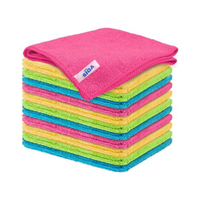It turns out there are approved techniques for cleaning a mirror without streaks – and some common household cleaning practices could be tainting the overall shine of your home’s mirrors, experts say. Here, professional cleaners have broken down the nine mirror cleaning mistakes you might be making, and explain what you can do instead.
Mirror cleaning mistakes
From dirty cloths to poor buffing, who knew these techniques would lead to a duller than ever mirror?
1. Using a dirty cloth
‘Using a dirty cloth is a common mirror cleaning mistake, and it is one that should be avoided for all household cleaning tips, says Alicia Sokolowski, president and co-CEO at the eco-friendly cleaning company, AspenClean (opens in new tab). ‘If you want to use a cloth that looks “clean” to you, but you haven’t actually washed it, then the chances are, it is not. There is likely dirt or dust left on it from your last clean, and you will be transferring old dust to your mirror.’
2. Using paper towels
When quickly cleaning a bathroom, it can be tempting to grab a paper towel from the bathroom vanity to quickly wipe the mirror down – but it often does more harm than good. ‘Many people use paper towels to clean mirrors, but the best thing to use is a microfiber cloth,’ advises Sara San Angelo, professional cleaner and founder of Confessions of a Cleaning Lady (opens in new tab). ‘Even the highest quality paper towels can leave lint on your mirror. Microfiber cloths are designed to absorb and trap anything they come into contact with, without leaving streaks or lint, provided your microfiber cloth is clean.’
3. Using the same sponge as the rest of the room
‘Using a sponge you already use for cleaning a bathroom sink or the toilet, for example, will only spread bacteria and grime around your bathroom,’ says Alicia Sokolowski of AspenClean. ‘Don’t make that mistake!'
4. Not removing dust before using cleaning products
Also a common window cleaning mistake, forgetting to remove dust with a cloth damp with water first will just spread the dirt around your mirrors as you try to buff. ‘If your mirror is particularly dirty or in a high-traffic area then the likelihood is that you will need to give it a deep clean before polishing it so as to remove the dust and dirt build-up,’ explains Laura Mountford of LauraCleanaholic. ‘To do this simply use a microfiber cloth, a small amount of washing-up liquid and warm water then wipe, then use a squeegee or window vac to remove the moisture before polishing it with either distilled white vinegar or a window and glass cloth.’
5. Using too much cleaner at a time
‘Using too much product can be difficult to remove, causing smears,’ explains Laura Mountford. ‘You only need to spritz a couple of times and you will have plenty of product for a sparkling shine.’
6. Spraying the product directly on the mirror
‘You should never spray products directly on a mirror,’ Alicia Sokolowski warns. ‘Adding cleaning products to the cloth instead is a better solution, not only to prevent over saturating the mirror (leading to streaks) but to help save cleaner, and therefore money, too.’
7. Not using a pattern when cleaning a mirror
‘Not having an organized pattern while cleaning mirrors is a lesser known mistake,’ adds AspenClean’s Alicia Sokolowski. ‘You should always clean from top to bottom and in horizontal lines across the mirror, or the most popular movement would be the “Z” shape, back and forth, still working from top to bottom.’
8. Not using a natural-based glass cleaner to add shine
‘A lot of household cleaning products have chemical or toxic products in their ingredients which are really bad for your health and the planet,’ Alica explains. ‘Switching to a natural/eco-friendly glass cleaner (like ours from AspenClean (opens in new tab)) that will put all the ingredients on the label should be one of your goals when it comes to cleaning.’
9. Not buffing once you have finished cleaning
Once the product has been removed, then you can buff the mirror with a dry cloth to help it shine, says Laura Mountford. ‘Be sure to wipe in a consistent motion when buffing your mirrors to get the best streak-free shine; I find the best way is to go top to bottom and buff in small circular motions.’ This Glass Cleaning Kit is all-natural. It contains Glass Cleaner & Microfiber Cloth and is your best solution for streak-free cleaning of your glass, windows & mirrors. The same technique can be applied to glass around the home too – from cleaning glass shower doors to cleaning windows without streaks.
Why is my mirror still dirty after cleaning it?
If your mirror still looks cloudy after cleaning it may be going through a process called desilvering. Typically seen on less expensive mirrors, desilvering is when the quality of the mirror degrades after years of cleaning. You may also begin to notice some black spots in the sheen too.
Will rubbing alcohol damage a mirror?
Rubbing alcohol is an effective cleaner for mirrors as it does not interact with the coating or scratches on the surface. It is an especially good cleaner if your mirror has become covered in makeup or hair care products such as sticky setting sprays and hairspray. Use rubbing alcohol on a clean cloth to wipe a mirror from top to bottom before wiping with plain water and drying to prevent streaks.

